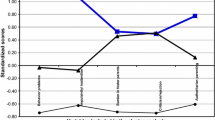Abstract
This study provides an overview of children, their families, and their circumstances at the time that the child entered foster care in Israel. Data regarding a representative sample of 800 children were collected as part of the ongoing operation of a clinical information system set up for Israel's foster care service in 1988. Implications of our findings for interventions are discussed.
Similar content being viewed by others
References
Maluccio AN, Fein E: Permanency planning: A redefinition.Child Welfare, 62: 195–201, 1983.
Kadushin A, Martin JA:Child welfare services (4th ed.). New York: Macmillan Publishing Co., 1988.
Barth RP: Emancipation services for adolescents in foster care.Soc Wk, 31 (May–June): 165–171, 1986.
Becker M, Austin S:Alternate care case inventory. Washington D.C.: DHSS, ACYF, 1983.
Cox M, Cox R.: Foster care and public policy.J Fam Issues, 5:182–199, 1984.
Fanshel D.:On the road to permanency: An expanded data base for service to children in foster care. New York: Child Welfare League of America, Inc., 1982.
Gershenson, C.:Child welfare population characteristics and flow analysis: FY 1982. Washington D.C.: ACYF, 1983.
Hubbel, R.:Foster care and families: Conflicting values and policies. Phila: Temple Univ Press, 1981.
Shyne AW, Schroeder AG:National study of social services to children and their families. Westat: Rockville, Md, 1978.
Vasaly SM:Foster care in five states: A synthesis and analysis of studies from Arizona, California, Iowa, Massachusetts, and Vermont. Washington, D.C.: U.S. Dept. of Health, Education, and Welfare, 1978.
Hochstadt NJ, Jaudes PK, Zimo DA, Schachter J: The medical and sociological needs of children entering foster care.Child Abuse Neglect, 11(1):53–62, 1987.
Seaberg JR, Tolley ES: Predictors of the length of stay in foster care.Soc Wk Res Abs, 22(3):11–17, 1986.
Benbenishty R, Oyserman D: A clinical information system for foster care in Israel.Child Welfare. 70:229–242, 1991.
Hays WL:Statistics for Psychologists. NY: Holt, Rinehart, and Winston, p 484, 1963.
Rowe J, Cain H, Hundleby M, Keane A:Long-term foster care. London: Batsford Academic and Educational, 1984.
Festinger TB:No One Ever Asked Us: A Postscript to Foster Care. New York: Columbia Univ Press, 1983.
Stone N, Stone, S.: The prediction of successful foster placement.Soc. Casewk, 64(1):11–17, 1983.
Author information
Authors and Affiliations
Rights and permissions
About this article
Cite this article
Oyserman, D., Benbenishty, R. & Ben-Rabi, D. Characteristics of children and their families at entry into foster care. Child Psych Hum Dev 22, 199–211 (1992). https://doi.org/10.1007/BF00705892
Received:
Revised:
Accepted:
Issue Date:
DOI: https://doi.org/10.1007/BF00705892




